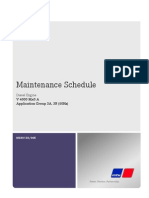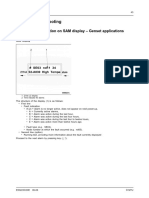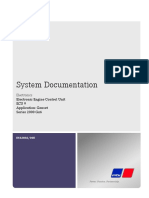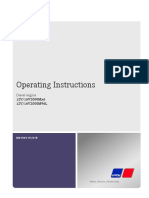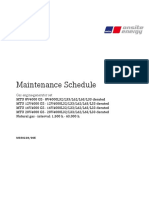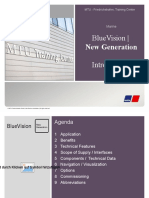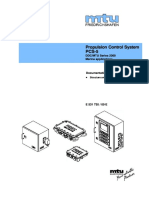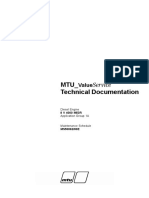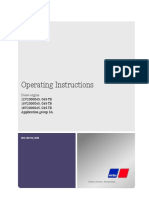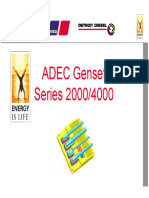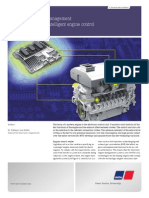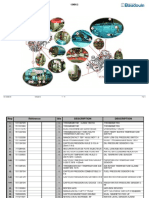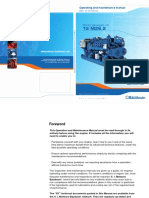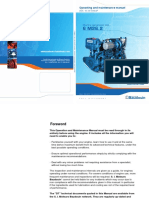Mtu 4000 Water Pump Dismantle
Mtu 4000 Water Pump Dismantle
Uploaded by
sxturboCopyright:
Available Formats
Mtu 4000 Water Pump Dismantle
Mtu 4000 Water Pump Dismantle
Uploaded by
sxturboOriginal Title
Copyright
Available Formats
Share this document
Did you find this document useful?
Is this content inappropriate?
Copyright:
Available Formats
Mtu 4000 Water Pump Dismantle
Mtu 4000 Water Pump Dismantle
Uploaded by
sxturboCopyright:
Available Formats
Task Descriptions 647
3.14 Coolant System
3.14.1 Coolant system – Overview
1 Coolant drain plug 15 Hose connection 29 Coolant pump
2 Coolant manifold, left 16 Hose connection 30 Restrictor
3 Coolant drain plug 17 Coolant inlet (HT) 31 Drain plug
4 Vent line 18 Coolant expansion line 32 Coolant manifold
5 Expansion tank 19 Measuring connection 33 Crankcase
6 Divider plate 20 Coolant inlet before pump 34 Drain plug
7 Filler neck 21 Measuring connection 35 End housing
8 Level monitor 22 Measuring connection 36 Thermostat, engine coolant
9 Heat exchanger (LT coolant circuit) 23 Coolant pump preheater
10 Fan cooler 24 Drain plug 37 Circulating pump
11 Heat exchanger (HT coolant circuit) 25 Thermostat (LT coolant circuit) 38 Non-return flap
12 Coolant inlet connection 26 Thermostat (HT coolant circuit) 39 Preheating unit
13 Measuring connection 27 Oil heat exchanger
14 Coolant expansion tank connection 28 Drain plug
M020109/01E 05-12 © MTU
648 Task Descriptions
3.14.2 Engine coolant pump – Overview
1 Engine coolant pump 4 Screw 7 Washer
2 O-ring 5 Screw
3 Screw 6 Nut
M020109/01E 05-12 © MTU
Task Descriptions 649
1 Water pump shaft 8 Angular-contact ball bearing 15 O-ring
2 Impeller 9 Cylindrical roller bearing 16 Screw
3 Bearing housing 10 Snap ring 17 Washer
4 Seal carrier 11 Shaft seal 18 Screw
5 Volute 12 Rotary seal 19 Washer
6 Spacer sleeve 13 O-ring 20 Sealing ring
7 Gear 14 O-ring 21 Plug screw
M020109/01E 05-12 © MTU
650 Task Descriptions
3.14.3 Engine coolant pump – Removal
Preconditions
• Engine is stopped and starting disabled.
Special tools
Designation / Use Part No. Qty.
Lifting gear T80091388 1
Support bracket T80091384 1
Heavy object.
Risk of crushing!
WARNING • Use appropriate lifting devices and appliances.
Components have sharp edges.
Risk of injury!
WARNING • Wear protective gloves.
Preparatory steps
When performing these tasks, a distinction must be made as to whether:
1 The engine is to be completely disassembled
2 The engine is removed but not to be disassembled
3 The engine is to remain installed
1 2 3 Operations See
X – – Remove engine (ĺ Page 63)
X – – Disassemble engine (ĺ Page 64)
– – X Disable engine start (ĺ Page 17)
– – X Drain engine coolant (ĺOperating Instructions)
– – X Remove coolant supply for engine coolant pump, (ĺ Page 673)
intake side
Engine coolant pump – Removal
1. Attach engine coolant pump with lifting gear and support bracket to crane using a slightly tensioned rope.
2. Screw in screws for engine coolant pump according to the overview drawing (ĺ Page 648) .
3. Use crowbar to separate engine coolant pump from front cover and remove.
4. Remove O-ring.
5. Seal openings with suitable covers.
M020109/01E 05-12 © MTU
Task Descriptions 651
3.14.4 Engine coolant pump – Disassembly
Special tools
Designation / Use Part No. Qty.
Hydraulic spindle F6781539 1
Removal tool for impeller F6780562 1
Removal tool for gear F6780561 1
Holding fixture F6781573 1
Carrier for several mandrels F30275611 1
Press fit tool F30379316 1
Snap ring pliers
Heavy object.
Risk of crushing!
WARNING • Use appropriate lifting devices and appliances.
Equipment can drop off.
Liquid is highly pressurized.
WARNING Risk of injury, knocks or crushing!
• Only use specified and tested equipment.
• Do not enter the danger zone.
• Wear protective clothing, gloves, and goggles / safety mask.
Spring/circlip/tensioning roller preload.
Risk of injury!
WARNING • Only use specified tool and equipment.
Remove engine coolant pump (ĺ Page 650).
Engine coolant pump – Disassembly
1. Mark installation position of bearing housing (1)
and volute (3) towards one another.
2. Remove all screws (2) securing the volute (3) to
the bearing housing (1).
3. Use crowbar to loosen volute (3) from bearing
housing (1) and take off.
M020109/01E 05-12 © MTU
652 Task Descriptions
4. Place engine coolant pump in (2) retaining
device (1).
5. Use hydraulic spindle (1) and removal tool for
impeller (2) to remove impeller (3) from water
pump shaft.
6. Holding the gear firmly in the retaining device
thoughout.
7. Take off impeller (3) from engine coolant pump.
8. Take engine coolant pump out of retaining device.
9. Place bearing housing (3) with pump shaft in vice
with aluminium jaws.
10. Use hydraulic spindle (1) and removal tool (2) to
remove gear from water pump shaft
M020109/01E 05-12 © MTU
Task Descriptions 653
11. Use snap ring pliers (4) to remove snap ring (2)
for cylindrical roller bearing (3) from bearing
housing (1).
12. Remove all screws (1) for seal carrier using a
box wrench (2).
13. Take bearing housing (2) out of vise and take
off seal carrier (1).
M020109/01E 05-12 © MTU
654 Task Descriptions
14. Use hydraulic press (1) to force pump shaft (2) off
bearing housing (3).
15. Place pump shaft (2) in holding fixture (6).
16. Press pump shaft (2) from inner race (3), spacer
sleeve (4) and angular-contact ball bearing (5) with
hydraulic press (1).
17. Use hydraulic press (1) and mandrel (2) to press
cylindrical roller bearing out of bearing housing (4).
M020109/01E 05-12 © MTU
Task Descriptions 655
18. Use screwdriver to press counterring (2) from
impeller (1).
19. Remove shaft seal, intermediate washer and
rotary shaft seal (arrow) from seal carrier (3) with
mandrel (2) and hydraulic press (1).
20. Remove all O-rings.
M020109/01E 05-12 © MTU
656 Task Descriptions
3.14.5 Engine coolant pump – Cleaning
Material
Designation / Use Part No. Qty.
Cleaning agent
Compressed air.
Risk of injury!
WARNING • Do not direct compressed-air jet at persons.
• Wear protective goggles / safety mask and ear protectors.
Excessive reaction time of cleaning agents on components.
Damage to component!
CAUTION • Observe manufacturer’s instructions.
• Wear protective clothing, gloves, and goggles / safety mask.
Disassemble engine coolant pump (ĺ Page 651).
Engine coolant pump – Cleaning
1. Clean all components with cleaning agent.
2. Remove cleaning agent.
3. Blow all components thoroughly with compressed air.
M020109/01E 05-12 © MTU
Task Descriptions 657
3.14.6 Engine coolant pump – Check
Special tools
Designation / Use Part No. Qty.
Precision bore gauge
Outside micrometer
Material
Designation / Use Part No. Qty.
Red penetrant dye for surface crack-testing procedure
Fluorescent magnetic powder for magnetic crack-testing procedure
Spare parts
Designation / Use Part No. Qty.
Engine coolant pump
Water pump shaft
Rotor
Bearing housing
Seal carrier
Volute
Spacer sleeve
Gear
Heavy object.
Risk of crushing!
WARNING • Use appropriate lifting devices and appliances.
Components have sharp edges.
Risk of injury!
WARNING • Wear protective gloves.
Clean engine coolant pump (ĺ Page 656).
M020109/01E 05-12 © MTU
658 Task Descriptions
Engine coolant pump – Check
Item Findings Task
Check volute and impeller for Cavitation visible. Replace
cavitation.
Check bearing housing, impeller Signs of cracks Replace
and volute with red dye penetrant
for cracks.
Check water pump shaft with Signs of cracks Replace
fluorescent magnetic powder for
cracks.
Check coolant pump shaft for wear • Wear traces • Reconditioning: smooth minor
and damage. • Damage traces of wear with emery cloth.
Visible • Replace
Visually inspect sealing surfaces for • Wear • Reconditioning: smooth with
wear, pitting and cavitation. • Pitting oilstone or emery cloth.
• Cavitation • Replace
Visible
Check gear for indentations, traces • Wear traces • Reconditioning: smooth with
of wear and damage. • Indentations oilstone or emery cloth.
• Damage • Replace gear.
Visible
Measure bearing seats and Values out of tolerance Replace
diameters on engine coolant pump,
impeller, seal carrier and bearing
housing and gear with inside and
outside micrometer. Values and
measuring points (ĺ Page 659)
M020109/01E 05-12 © MTU
Task Descriptions 659
3.14.7 Engine coolant pump – Tolerances
No. Designation Stage Tol. size Deviation Clearance Interference Wear
Basic limit
size
lower upper min. max. min. max.
1 Seal carrier 90.000 K7 í0.025 +0.010 0.025 0.025
Angular-contact 90.000 í0.015 0
ball bearing outer
diam.
2 Bearing housing 90.000 K7 í0.025 +0.010 0.025 0.025
bore
Angular-contact 90.000 í0.015 0
ball bearing
outer diam.
3 Angular contact 40.000 í0.012 0 0.002 0.025
ball bearing bore
Shaft outer diam. 40.000 k5 +0.002 +0.013
4 Spacer sleeve 40.000 N7 í0.033 –0.008 0.010 0.046
bore
Shaft outer diam. 40.000 k5 +0.002 +0.013
5 Bearing housing 80.000 K7 í0.021 +0.009 0.022 0.021
bore
Cylindrical roller 80.000 í0.013 0
bearing
M020109/01E 05-12 © MTU
660 Task Descriptions
No. Designation Stage Tol. size Deviation Clearance Interference Wear
Basic limit
size
lower upper min. max. min. max.
6 Cylindrical roller 40.000 í0.012 0 0.002 0.025
bearing bore
Shaft outer diam. 40.000 k5 +0.002 +0.013
7 Gear bore 39.000 H7 0 +0.025 0.018 0.059
Shaft outer diam. 39.000 s6 +0.043 +0.059
M020109/01E 05-12 © MTU
Task Descriptions 661
No. Designation Stage Tol. size Deviation Clearance Interference Wear
Basic limit
size
lower upper min. max. min. max.
1 Sealing-ring 72.000 H8 0 +0.046 0.084 0.230
holder bore
Shaft seal outer 72.000 +0.130 +0.230
diam.
2 Shaft outer diam. 48.000 í0.100 0
If running surface is worn: Recondition pump shaft by spray-metallizing and plunge-cut grinding.
3 Sealing-ring 78.100 H7 0 +0.030 0.040 0.100
holder bore
Rotary seal outer 78.200 í0.030 0
diam.
4 Impeller bore 30.000 H5 0 +0.009 0.032 0.050
Shaft outer diam. 30.000 t5 +0.041 +0.050
5 Rotary seal
Counterring
If wear traces are found: Replace components together
M020109/01E 05-12 © MTU
662 Task Descriptions
3.14.8 Engine coolant pump – Assembly
Special tools
Designation / Use Part No. Qty.
Press fit tool for angular-contact ball bearings F30378152 1
Press fit tool for ball bearings F30378153 1
Press fit tool for shaft seal F30378550 1
Press fit tool for rotary seal F30378151 1
Support for bearing housing F6780563 1
Carrier for several mandrels F30275611 1
Retaining device F6780561 1
Snap ring pliers
Material
Designation / Use Part No. Qty.
Denatured ethanol
Petroleum jelly, white
Engine oil
Spare parts
Designation / Use Part No. Qty.
Angular-contact ball bearing
Cylindrical roller bearing
Snap ring
Shaft seal
Rotary seal
O-ring
Component is hot.
Risk of burning!
WARNING • Wear protective gloves.
Heavy object.
Risk of crushing!
WARNING • Use appropriate lifting devices and appliances.
Spring/circlip/tensioning roller preload.
Risk of injury!
WARNING • Only use specified tool and equipment.
Contamination of components.
Damage to component!
CAUTION • Observe manufacturer’s instructions.
• Check components for special cleanness.
Check engine coolant pump (ĺ Page 657).
M020109/01E 05-12 © MTU
Task Descriptions 663
Engine coolant pump – Assembly
Note: Apply pressure to bearing outer race.
1. Use hydraulic press (1) and mandrel (2) to press
cylindrical roller bearing into bearing housing (4).
2. Place snap ring (2) in groove of bearing
housing (3), using snap ring pliers (1).
3. Check that snap ring (2) is correctly seated.
4. Force angular-contact ball bearing (3) onto pump
shaft (4) with hydraulic press (1) and mandrel (2).
M020109/01E 05-12 © MTU
664 Task Descriptions
5. Force spacer sleeve (3) onto pump shaft (4) with
hydraulic press (1) and mandrel (2).
6. Press inner race (2) of cylindrical roller bearing
onto pump shaft (3) with hydraulic press and
mandrel (1).
Note: Apply pressure to bearing outer race (3).
7. Use hydraulic press (1) and mandrel (2) to press
pump shaft into bearing housing (4).
M020109/01E 05-12 © MTU
Task Descriptions 665
Note: Ensure that the shaft seal (2) is correctly
seated.
8. Insert shaft seal (2) into press-in mandrel (1).
9. Use hydraulic press (1) and mandrel (2) to press
shaft seal into seal carrier (3).
10. Place intermediate washer in seal carrier (4).
11. Coat rotary shaft seal (3) with a soap solution
(water : soap mixture = 2:1).
12. Use hydraulic press (1) and mandrel (2) to press
rotary shaft seal (3) into seal carrier (4).
13. Clean running surface with denatured ethanol
after assembly.
M020109/01E 05-12 © MTU
666 Task Descriptions
14. Coat O-ring with petroleum jelly and place into
groove.
15. Place bearing housing (1) in holding fixture (4).
16. Use screws (2) to install seal carrier on bearing
housing (1) and tighten them evenly.
17. Heat gear (2) to 200 °C.
18. Place bearing housing (3) with seal carrier and
holding fixture (4) onto hydraulic press (1).
19. Use hydraulic press (1) to push heated gear (2)
onto shaft to stop position and hold until shrink
connection between shaft and gear is fixed.
Note: Insert counterring (2) only after heating.
20. Heat impeller (1) to 210 °C.
21. Coat O-ring with petroleum jelly and place into
counterring (2).
22. Place counterring (2) in heated impeller (1).
23. Clean counterring surface with denatured ethanol.
M020109/01E 05-12 © MTU
Task Descriptions 667
24. Place engine coolant pump onto hydraulic
press (1).
25. Place two feeler gauges (clearance
S1 = 0.7 mm to 1.1 mm), on seal carrier (3)
arranged at 180° towards one another.
26. Push heated impeller (2) with hydraulic press (1)
until it stops at feeler gauges.
27. Measure clearance S1 between impeller (2) and
seal carrier (3) with feeler gauge.
28. If measured value is out of tolerance, determine
the cause and replace components, if necessary.
29. Set volute (3) onto bearing housing (1) according
to the installation position marking made before
removal.
30. Tighten screws (2).
31. Turn pump shaft to check freedom of rotation.
32. Measure clearance S2 (0.6 mm to 1.5 mm)
between impeller and volute (3) with feeler gauge.
33. If measured value is out of tolerance, determine
the cause and replace components, if necessary.
M020109/01E 05-12 © MTU
668 Task Descriptions
3.14.9 Engine coolant pump – Installation
Special tools
Designation / Use Part No. Qty.
Lifting gear T80091388 1
Support bracket T80091384 1
Material
Designation / Use Part No. Qty.
Petroleum jelly, white
Engine oil
Spare parts
Designation / Use Part No. Qty.
O-ring
Heavy object.
Risk of crushing!
WARNING • Use appropriate lifting devices and appliances.
Components have sharp edges.
Risk of injury!
WARNING • Wear protective gloves.
Assemble engine coolant pump (ĺ Page 662).
Engine coolant pump – Installation
1. Remove all covers prior to installation.
2. Coat O-ring (1) with petroleum jelly.
3. Insert O-ring (1) in groove on bearing housing of
engine coolant pump.
M020109/01E 05-12 © MTU
Task Descriptions 669
4. Attach engine coolant pump with lifting gear
and support bracket to crane using a slightly
tensioned rope.
Note: Make sure that gears are correctly meshed.
5. Install coolant pump (1) in bore on equipment
carrier, ensuring it is correctly positioned.
6. Install screws (2) and washers and tighten
uniformly.
7. Remove lifting gear and support bracket.
Final steps
When performing these tasks, a distinction must be made as to whether:
1 The engine has been completely disassembled
2 The engine is removed but not disassembled
3 The engine is installed
1 2 3 Operations See
X – – Assemble engine (ĺ Page 67)
X – – Install engine (ĺ Page 69)
– – X Fill engine coolant (ĺOperating Instructions)
– – X Assemble in reverse sequence to disassembly (ĺ Page 650)
– – X Enable engine start –
M020109/01E 05-12 © MTU
670 Task Descriptions
3.14.10 Coolant supply for engine coolant pump, intake side – Overview
Elbow with attachments
1 Elbow 6 Washer 11 Connector
2 Plug 7 Bracket 12 Banjo screw
3 Sealing ring 8 Hex screw 13 Sealing ring
4 O-ring 9 Washer
5 Hex screw 10 Drain valve
M020109/01E 05-12 © MTU
Task Descriptions 671
Plug-in pipe with flange
1 Plug-in pipe
2 O-ring
3 Flange
4 Hex screw
5 O-ring
M020109/01E 05-12 © MTU
672 Task Descriptions
Coolant pipework
1 Plug-in pipe 4 Hex screw 7 O-ring
2 O-ring 5 O-ring 8 Flange
3 Flange 6 Plug-in pipe 9 Hex screw
M020109/01E 05-12 © MTU
Task Descriptions 673
3.14.11 Engine coolant pump pipework, intake side – Removal
Preconditions
• Engine is stopped and starting disabled.
Preparatory steps
A distinction must be made as to whether
1 the engine is to be completely disassembled
2 the engine is to be removed but not disassembled
3 the engine is to remain installed
1 2 3 Operations See
x – – Remove engine (ĺ Page 63)
x – – Disassemble engine (ĺ Page 64)
– – x Disable engine start (ĺ Page 17)
– – x Drain engine coolant (ĺOperating Instructions)
Removing coolant lines
1. Before removing the lines it is advisable to take photographs of the fitted lines or to mark lines and attachments.
2. Remove all monitoring units installed in coolant lines.
3. Remove lines as shown in overview drawing (ĺ Page 670) .
4. Seal all openings with suitable plugs.
M020109/01E 05-12 © MTU
674 Task Descriptions
3.14.12 Coolant supply for engine coolant pump, intake side – Cleaning
Special tools
Designation / Use Part No. Qty.
Cleaning brush
Material
Designation / Use Part No. Qty.
Cleaning agent
Compressed air.
Risk of injury!
WARNING • Do not direct compressed-air jet at persons.
• Wear protective goggles / safety mask and ear protectors.
Excessive reaction time of cleaning agents on components.
Damage to component!
CAUTION • Observe manufacturer’s instructions.
• Wear protective clothing, gloves, and goggles / safety mask.
Unsuitable cleaning tools.
Damage to component!
CAUTION • Observe manufacturer’s instructions.
• Use appropriate cleaning tool.
Remove coolant supply for engine coolant pump, intake side (ĺ Page 673).
Cleaning coolant lines
1. Clean coolant lines with cleaning agent and cleaning brush.
2. Remove cleaning agent.
3. Blow dry coolant lines with compressed air and preserve in oil bath.
M020109/01E 05-12 © MTU
Task Descriptions 675
3.14.13 Engine coolant pump pipework, intake side – Check
Spare parts
Designation / Use Part No. Qty.
Elbow
Flange
Plug-in pipe
Bracket
Connector
Drain valve
Compressed air is pressurized.
Risk of injury!
WARNING • Pressure must not exceed 0.5 bar.
• Wear protective clothing, gloves, and goggles / safety mask.
Clean engine coolant pump pipework, intake side (ĺ Page 674).
Engine coolant pump pipework, intake side – Check
Item Findings Action
Visually inspect brackets, plug-in • Wear • Recondition: smooth with
connections and annular grooves on • Pitting oilstone or emery cloth.
elbows and connecting lines for wear, • Cavitation • Replace
pitting and cavitation. visible
Check sealing and mating faces for Damaged • Recondition: smooth with
wear and damage. oilstone or emery cloth.
• Replace
Pressure-test coolant lines with air Leaking Replace
in water bath for leaks as necessary.
Maintain a coolant temperature of min.
= 30 °C or max. = 40 °C at a test
pressure of 0.5 bar.
Check operation of drain valve. Damaged Replace
M020109/01E 05-12 © MTU
676 Task Descriptions
3.14.14 Engine coolant pump pipework, intake side – Installation
Material
Designation / Use Part No. Qty.
Petroleum jelly, white
Engine oil
Spare parts
Designation / Use Part No. Qty.
Sealing rings
O-rings
Compressed air.
Risk of injury!
WARNING • Do not direct compressed-air jet at persons.
• Wear protective goggles / safety mask and ear protectors.
Check engine coolant pump pipework, intake side (ĺ Page 675).
Installing coolant lines
1. Remove all plugs.
2. Blow out coolant lines with compressed air.
3. Coat all O-rings with petroleum jelly.
4. Install coolant lines with new sealing rings and O-rings as per overview drawing (ĺ Page 670), ensuring they
are free from tension.
5. Install all monitoring units in coolant lines.
Final steps
A distinction must be made as to whether
1 the engine was completely disassembled
2 the engine was removed but not disassembled
3 the engine is still installed
1 2 3 Operations See
x – – Assemble engine (ĺ Page 67)
x – – Install engine (ĺ Page 69)
– x x Fill engine coolant system (ĺOperating Instructions)
– x x Release engine start –
M020109/01E 05-12 © MTU
Task Descriptions 677
3.14.15 Coolant pipework after cylinder – Overview
Coolant pipework after cylinder – Overview
Also applies analogously to 12 V.
1 Connecting piece 7 O-ring 13 O-ring
2 Screw 8 Plug 14 O-ring
3 O-ring 9 Coolant manifold 15 O-ring
4 Connecting piece 10 Coolant manifold 16 Screw
5 Screw 11 Coolant manifold 17 Screw
6 Screw 12 Coolant manifold
M020109/01E 05-12 © MTU
678 Task Descriptions
3.14.16 Coolant pipework after cylinder – Removal
Preconditions
• Engine is stopped and starting disabled.
Preparatory steps
A distinction must be made as to whether
1 the engine is to be completely disassembled
2 the engine is to be removed but not disassembled
3 the engine is to remain installed
1 2 3 Operations See
x – – Remove engine (ĺ Page 63)
x – – Perform operations as per Disassembly Plan (ĺ Page 64)
– – x Disable engine start (ĺ Page 17)
– – x Drain engine coolant (ĺOperating Instructions)
Removing coolant lines
1. Remove lines as shown in overview drawing (ĺ Page 677) .
2. After removal, seal all connections with plugs.
M020109/01E 05-12 © MTU
Task Descriptions 679
3.14.17 Coolant pipework after cylinder – Cleaning
Special tools
Designation / Use Part No. Qty.
Cleaning brush
Material
Designation / Use Part No. Qty.
Cleaning agent
Compressed air.
Risk of injury!
WARNING • Do not direct compressed-air jet at persons.
• Wear protective goggles / safety mask and ear protectors.
Unsuitable cleaning tools.
Damage to component!
CAUTION • Observe manufacturer’s instructions.
• Use appropriate cleaning tool.
Excessive reaction time of cleaning agents on components.
Damage to component!
CAUTION • Observe manufacturer’s instructions.
• Wear protective clothing, gloves, and goggles / safety mask.
Remove coolant pipework after cylinder (ĺ Page 678).
Coolant pipework after cylinder – Cleaning
1. Clean coolant pipework after cylinder with cleaning agent and cleaning brush.
2. Remove cleaning agent.
3. Thoroughly blow out coolant pipework after cylinder with compressed air and preserve in oil bath.
M020109/01E 05-12 © MTU
680 Task Descriptions
3.14.18 Coolant pipework after cylinder – Check
Spare parts
Designation / Use Part No. Qty.
Coolant manifold
Connector
Compressed air.
Risk of injury!
WARNING • Do not direct compressed-air jet at persons.
• Wear protective goggles / safety mask and ear protectors.
Compressed air is pressurized.
Hot testing liquid.
WARNING Risk of injury and scalding!
• Pressure must not exceed 0.5 bar.
• Wear protective clothing, gloves, and goggles / safety mask.
Clean coolant pipework after cylinder (ĺ Page 679).
Coolant pipework after cylinder – Check
Item Findings Action
Visually inspect plug-in connections and Damaged • Recondition: smooth with
annular grooves on connector and manifold oilstone or emery cloth.
for wear, pitting and cavitation. • Replace
Check coolant lines for leaks in water Leaking Replace
bath, using compressed air and corrosion
inhibitor. Maintain a coolant temperature
of min. = 30 °C or max. = 40 °C at a test
pressure of 0.5 bar.
M020109/01E 05-12 © MTU
Task Descriptions 681
3.14.19 Coolant pipework after cylinder – Installation
Material
Designation / Use Part No. Qty.
Engine oil
Petroleum jelly, white
Spare parts
Designation / Use Part No. Qty.
O-ring
Compressed air.
Risk of injury!
WARNING • Do not direct compressed-air jet at persons.
• Wear protective goggles / safety mask and ear protectors.
Check coolant pipework after cylinder (ĺ Page 680).
Coolant pipework after cylinder – Installation
1. Remove all plugs.
2. Blow out coolant pipework with compressed air.
3. Coat O-rings with petroleum jelly.
4. Install coolant pipework after cylinder as shown in overview drawing, (ĺ Page 677) ensuring they are free
from tension.
Final steps
A distinction must be made as to whether
1 the engine was completely disassembled
2 the engine was removed but not disassembled
3 the engine is still installed
1 2 3 Operations See
x – – Assemble engine (ĺ Page 67)
x – – Install engine (ĺ Page 69)
– x x Fill engine coolant system (ĺOperating Instructions)
– x x Release engine start –
M020109/01E 05-12 © MTU
682 Task Descriptions
3.14.20 Preheating unit – Repair
Preheating unit – Repair
See special publication M060715.
M020109/01E 05-12 © MTU
Task Descriptions 683
3.14.21 Engine coolant drain lines – Overview
Coolant lines
1 Pipe 10 Blanking cone 19 Spacer bush
2 Blanking cone 11 Nut 20 Bracket
3 Nut 12 Bracket 21 Hex screw
4 Pipe 13 Pipe clamp half 22 Spacer bush
5 Pipe 14 Grommet 23 Pipe clamp half
6 Blanking cone 15 Hex screw 24 Pipe clamp half
7 Nut 16 Washer 25 Grommet
8 Pipe 17 Hex nut 26 Hex screw
9 T-piece 18 Hex screw
M020109/01E 05-12 © MTU
684 Task Descriptions
3.14.22 Engine coolant drain lines – Removal
Preconditions
• Engine is stopped and starting disabled.
Preparatory steps
When performing these tasks, a distinction must be made as to whether:
1 The engine is to be completely disassembled
2 The engine is to be removed but not disassembled
3 The engine is to remain installed
1 2 3 Operations See
x – – Remove engine (ĺ Page 63)
x – – Disassemble engine (ĺ Page 64)
– – x Disable engine start (ĺ Page 17)
– – x Drain engine coolant (ĺOperating Instructions)
Removing drain lines
1. Before removing the lines it is advisable to take photographs of the fitted lines or to mark lines and attachments.
2. Remove lines as shown in overview drawing (ĺ Page 683).
3. After removal, seal all connections with suitable plugs.
M020109/01E 05-12 © MTU
Task Descriptions 685
3.14.23 Engine coolant drain lines – Cleaning
Special tools
Designation / Use Part No. Qty.
Cleaning brush
Material
Designation / Use Part No. Qty.
Cleaning agent
Compressed air.
Risk of injury!
WARNING • Do not direct compressed-air jet at persons.
• Wear protective goggles / safety mask and ear protectors.
Excessive reaction time of cleaning agents on components.
Damage to component!
CAUTION • Observe manufacturer’s instructions.
• Wear protective clothing, gloves, and goggles / safety mask.
Unsuitable cleaning tools.
Damage to component!
CAUTION • Observe manufacturer’s instructions.
• Use appropriate cleaning tool.
Remove engine coolant drain lines (ĺ Page 684).
Engine coolant drain lines – Cleaning
1. Clean coolant drain lines with cleaning agent and cleaning brush.
2. Remove cleaning agent.
3. Blow dry coolant drain lines with compressed air and preserve in oil bath.
M020109/01E 05-12 © MTU
686 Task Descriptions
3.14.24 Engine coolant drain lines – Check
Spare parts
Designation / Use Part No. Qty.
Pipe
Blanking cone
T-piece
Bracket
Spacer bush
Compressed air is pressurized.
Risk of injury!
WARNING • Pressure must not exceed 0.5 bar.
• Wear protective clothing, gloves, and goggles / safety mask.
Compressed air.
Risk of injury!
WARNING • Do not direct compressed-air jet at persons.
• Wear protective goggles / safety mask and ear protectors.
Clean coolant drain lines (ĺ Page 685).
Engine coolant drain lines – Check
Item Findings Action
Check T-piece, brackets and lines for Damaged Replace
damage.
Pressure-test coolant lines with air and Leaking Replace
corrosion inhibitor in water bath for
leaks as necessary. Maintain a coolant
temperature of min. = 30 °C or max.
= 40 °C at a test pressure of 0.5 bar.
Check thread and damage for ease of Damaged or sluggish • Recondition: recut threads
movement • Replace
M020109/01E 05-12 © MTU
Task Descriptions 687
3.14.25 Engine coolant drain lines – Installation
Material
Designation / Use Part No. Qty.
Engine oil
Spare parts
Designation / Use Part No. Qty.
Grommet
Compressed air.
Risk of injury!
WARNING • Do not direct compressed-air jet at persons.
• Wear protective goggles / safety mask and ear protectors.
Check engine coolant drain lines (ĺ Page 686).
Engine coolant drain lines – Installation
1. Remove all blanking plugs.
2. Blow out coolant drain lines with compressed air.
3. Install coolant drain lines as shown in overview drawing (ĺ Page 683)free of tension and secure with pipe
half-clamps.
Final steps
When performing these tasks, a distinction must be made as to whether:
1 The engine is completely disassembled
2 The engine is removed but not disassembled
3 The engine is still installed
1 2 3 Operations See
x – – Assemble engine (ĺ Page 67)
x – – Install engine (ĺ Page 69)
– x x Fill engine coolant system (ĺOperating Instructions)
– x x Enable engine start –
M020109/01E 05-12 © MTU
688 Task Descriptions
3.14.26 Engine coolant and charge-air coolant ventilation – Overview
Engine coolant vent lines
1 Union 20 Sealing ring 39 Union
2 Sealing ring 21 Pipe 40 Sealing ring
3 Pipe 22 Holder 41 Union
4 Holder 23 Pipe half-clamp 42 Sealing ring
5 Pipe half-clamp 24 Grommet 43 Pipe
6 Grommet 25 Screw 44 Bracket
7 Screw 26 T-piece 45 Pipe half-clamp
8 Union 27 Pipe 46 Grommet
9 Sealing ring 28 Union 47 Screw
10 Vent line 29 Sealing ring 48 Spacer bush
11 T-piece 30 Pipe 49 Pipe half-clamp
12 Pipe 31 T-piece 50 Grommet
13 Holder 32 Pipe 51 Screw
14 Pipe half-clamp 33 Union 52 Pipe
15 Grommet 34 Sealing ring 53 Pipe
16 Screw 35 Pipe 54 Union
17 T-piece 36 Union 55 Sealing ring
18 Vent line 37 Sealing ring
19 Union 38 Pipe
M020109/01E 05-12 © MTU
Task Descriptions 689
Engine coolant vent lines
1 Elbow 15 Elbow 29 Holder
2 Threaded union 16 Threaded union 30 Pipe half-clamp
3 Sealing ring 17 Distributor piece 31 Pipe half-clamp
4 T-piece 18 Holder 32 Screw
5 Pipe 19 Screw 33 Washer
6 Union 20 Washer 34 Pipe half-clamp
7 Sealing ring 21 Plug screw 35 Pipe half-clamp
8 Pipe 22 Plug screw 36 Grommet
9 Threaded union 23 Sealing ring 37 Screw
10 Union 24 Sealing ring 38 Pipe half-clamp
11 Sealing ring 25 Union 39 Pipe half-clamp
12 Pipe 26 Sealing ring 40 Spacer sleeve
13 T-piece 27 Blanking cone 41 Grommet
14 Pipe 28 Nut 42 Screw
M020109/01E 05-12 © MTU
690 Task Descriptions
3.14.27 Engine coolant ventilation and charge air cooling – Removal
Preconditions
• Engine is stopped and starting disabled.
Preparatory steps
When performing these tasks, a distinction must be made as to whether:
1 The engine is to be completely disassembled
2 The engine is to be removed but not disassembled
3 The engine is to remain installed
1 2 3 Operations See
x – – Remove engine (ĺ Page 63)
x – – Disassemble engine (ĺ Page 64)
– – x Disable engine start (ĺ Page 17)
– – x Drain engine coolant (ĺOperating Instructions)
Removing vent lines
1. Before removing the lines it is advisable to take photographs of the fitted lines or to mark lines and attachments.
2. Remove lines as shown in overview drawing (ĺ Page 688).
3. After removal, seal all connections with suitable plugs.
M020109/01E 05-12 © MTU
Task Descriptions 691
3.14.28 Engine coolant ventilation and charge air cooling – Cleaning
Special tools
Designation / Use Part No. Qty.
Cleaning brush
Material
Designation / Use Part No. Qty.
Cleaning agent
Compressed air.
Risk of injury!
WARNING • Do not direct compressed-air jet at persons.
• Wear protective goggles / safety mask and ear protectors.
Unsuitable cleaning tools.
Damage to component!
CAUTION • Observe manufacturer’s instructions.
• Use appropriate cleaning tool.
Excessive reaction time of cleaning agents on components.
Damage to component!
CAUTION • Observe manufacturer’s instructions.
• Wear protective clothing, gloves, and goggles / safety mask.
Remove engine coolant ventilation and charge air cooling (ĺ Page 690).
Engine coolant ventilation and charge air cooling – Cleaning
1. Clean coolant ventilation and charge air cooling with cleaning agent and cleaning brush.
2. Remove cleaning agent.
3. Thoroughly blow out coolant ventilation and charge air cooling with compressed air and preserve in oil bath.
M020109/01E 05-12 © MTU
692 Task Descriptions
3.14.29 Engine coolant and charge air coolant ventilation – Check
Spare parts
Designation / Use Part No. Qty.
Pipe
Elbow
Vent line
Distributor
T-piece
Bracket
Angle
Spacer sleeve
Compressed air is pressurized.
Risk of injury!
WARNING • Pressure must not exceed 0.5 bar.
• Wear protective clothing, gloves, and goggles / safety mask.
Compressed air.
Risk of injury!
WARNING • Do not direct compressed-air jet at persons.
• Wear protective goggles / safety mask and ear protectors.
Clean engine coolant and charge air coolant ventilation (ĺ Page 691).
Engine coolant and charge air coolant ventilation – Check
Item Findings Action
Check lines, elbow, distributor, T-piece, retainer, Damaged Replace
bracket and spacer sleeve for damage.
Check coolant lines for leaks in water bath, using Leaking Replace
compressed air and corrosion inhibitor. Maintain a
coolant temperature of min. = 30 °C or max. = 40 °C
at a test pressure of 0.5 bar.
Check thread and damage for ease of movement. Damaged or sluggish • Recondition: recut
threads
• Replace
M020109/01E 05-12 © MTU
Task Descriptions 693
3.14.30 Engine coolant ventilation and charge air cooling – Installation
Material
Designation / Use Part No. Qty.
Engine oil
Spare parts
Designation / Use Part No. Qty.
Grommet
Pipe half-clamp
Compressed air.
Risk of injury!
WARNING • Do not direct compressed-air jet at persons.
• Wear protective goggles / safety mask and ear protectors.
Check engine coolant ventilation and charge air cooling system (ĺ Page 692).
Engine coolant ventilation and charge air cooling – Installation
1. Remove all plugs.
2. Blow out coolant ventilation and charge air cooling with compressed air.
3. Install engine coolant ventilation and charge air cooling as shown in overview drawing (ĺ Page 688) free of
tension and secure with pipe half-clamps.
Final steps
A distinction must be made whether:
1 The engine is completely disassembled
2 The engine is removed but not disassembled
3 The engine is installed
1 2 3 Operations See
x – – Assemble engine (ĺ Page 67)
x – – Install engine (ĺ Page 69)
– x x Fill engine coolant system (ĺOperating Instructions)
– x x Fill charge-air cooling system (not applicable to marine (ĺOperating Instructions)
applications)
– x x Enable engine start –
M020109/01E 05-12 © MTU
694 Task Descriptions
3.14.31 Coolant pipework from/to exhaust turbochargers – Overview
1 Adapter 14 Sealing ring 27 Grommet
2 Sealing ring 15 Coolant line 28 Washer
3 Coolant line 16 Adapter 29 Screw
4 Adapter 17 Sealing ring 30 Adapter
5 Sealing ring 18 Coolant line 31 Sealing ring
6 Coolant line 19 Adapter 32 Coolant line
7 Bracket 20 Sealing ring 33 Pipe half-clamp
8 Pipe half-clamp 21 Coolant line 34 Pipe half-clamp
9 Pipe half-clamp 22 Adapter 35 Grommet
10 Grommet 23 Sealing ring 36 Washer
11 Washer 24 Coolant line 37 Screw
12 Screw 25 Pipe half-clamp
13 Adapter 26 Pipe half-clamp
M020109/01E 05-12 © MTU
Task Descriptions 695
3.14.32 Coolant pipework from/to exhaust turbocharger – Removal
Preconditions
• Engine is stopped and starting disabled.
Preparatory steps
When performing these tasks, a distinction has to be made as to whether:
1 the engine is to be completely disassembled
2 the engine is removed but not to be disassembled
3 the engine is to remain installed
1 2 3 Operations See
X – – Remove engine (ĺ Page 63)
X – – Disassemble engine (ĺ Page 64)
– – X Disable engine start (ĺ Page 17)
– – X Drain engine coolant (ĺOperating Instructions)
Removing coolant lines
1. Before removing the lines, take photos or label add-on components and lines.
2. Remove lines as shown in overview drawing (ĺ Page 688).
3. Seal openings with suitable covers.
M020109/01E 05-12 © MTU
696 Task Descriptions
3.14.33 Coolant pipework from/to exhaust turbochargers – Cleaning
Material
Designation / Use Part No. Qty.
Cleaning agent
Compressed air.
Risk of injury!
WARNING • Do not direct compressed-air jet at persons.
• Wear protective goggles / safety mask and ear protectors.
Unsuitable cleaning tools.
Damage to component!
CAUTION • Observe manufacturer’s instructions.
• Use appropriate cleaning tool.
Excessive reaction time of cleaning agents on components.
Damage to component!
CAUTION • Observe manufacturer’s instructions.
• Wear protective clothing, gloves, and goggles / safety mask.
Install coolant pipework from/to exhaust turbocharger (ĺ Page 695).
Coolant pipework from/to exhaust turbochargers – Cleaning
1. Clean parts with cleaning agent and cleaning brush.
2. Remove cleaner.
3. Thoroughly blow out all parts with compressed air.
M020109/01E 05-12 © MTU
Task Descriptions 697
3.14.34 Coolant pipework from/to turbochargers – Check
Spare parts
Designation / Use Part No. Qty.
Coolant line
Bracket
Pipe half-clamp
Grommet
Compressed air is pressurized.
Risk of injury!
WARNING • Pressure must not exceed 0.5 bar.
• Wear protective clothing, gloves, and goggles / safety mask.
Compressed air.
Risk of injury!
WARNING • Do not direct compressed-air jet at persons.
• Wear protective goggles / safety mask and ear protectors.
Clean coolant pipework from/to exhaust turbochargers (ĺ Page 696).
Coolant pipework from/to turbochargers – Check
Item Findings Measure
Visually check lines, pipe clamp halves, Damaged Replace
grommets and brackets for damage.
Check coolant lines for leaks in water bath, Leaking Replace
using compressed air and corrosion inhibitor.
Maintain a coolant temperature of min. = 30 °C
or max. = 40 °C at a test pressure of 0.5 bar.
M020109/01E 05-12 © MTU
698 Task Descriptions
3.14.35 Coolant pipework from/to turbochargers – Installation
Material
Designation / Use Part No. Qty.
Engine oil
Petroleum jelly, white
Contamination of components.
Damage to component!
CAUTION • Observe manufacturer’s instructions.
• Check components for special cleanness.
Incorrect installation of components and lines.
Damage to component!
CAUTION • Ensure that components/lines are installed so that they are never under tension or strain.
• Ensure correct installation position of components.
Check coolant pipework from/to exhaust turbocharger (ĺ Page 697).
Coolant pipework from/to turbochargers – Installation
1. Before installation, remove all covers.
2. Install coolant pipework from/to exhaust turbocharger as shown in overview drawing (ĺ Page 694).
Final steps
When performing these tasks, a distinction has to be made as to whether:
1 the engine was completely disassembled
2 the engine is removed but was not disassembled
3 the engine is still installed
1 2 3 Operations See
X – – Assemble engine (ĺ Page 67)
X – – Install engine (ĺ Page 69)
– X X Fill engine coolant system (ĺOperating Instructions)
– X X Enable engine start –
M020109/01E 05-12 © MTU
Task Descriptions 699
3.14.36 Charge-air coolant pump – Overview
Charge-air coolant pump – Overview
1 Charge-air coolant pump 4 Screw 7 Drain valve
2 O-ring 5 Nut
3 Screw 6 Washer
M020109/01E 05-12 © MTU
700 Task Descriptions
1 Water pump shaft 8 Angular-contact ball bearing 15 Screw
2 Impeller 9 Cylindrical roller bearing 16 Washer
3 Bearing housing 10 Snap ring 17 O-ring
4 Seal carrier 11 Shaft seal 18 Screw
5 Volute 12 Rotary seal 19 Washer
6 Spacer sleeve 13 O-ring
7 Gear 14 O-ring
M020109/01E 05-12 © MTU
Task Descriptions 701
3.14.37 Charge-air coolant pump – Removal
Preconditions
• Engine is stopped and starting disabled.
Heavy object.
Risk of crushing!
WARNING • Use appropriate lifting devices and appliances.
Components have sharp edges.
Risk of injury!
WARNING • Wear protective gloves.
Preparatory steps
A distinction must be made as to whether
1 the engine is to be completely disassembled
2 the engine is to be removed but not disassembled
3 the engine is to remain installed
1 2 3 Operations See
X – – Remove engine (ĺ Page 63)
X – – Disassemble engine (ĺ Page 64)
– – X Disable engine start (ĺ Page 17)
– – X Drain charge-air coolant (ĺOperating Instructions)
Charge-air coolant pump – Removal
1. Remove securing screws for engine coolant pump as shown in overview drawing (ĺ Page 699) .
2. Use crowbar to separate charge-air coolant pump from equipment carrier and remove.
3. Mask installation hole for charge-air coolant pump.
4. Remove O-ring from charge-air coolant pump.
M020109/01E 05-12 © MTU
702 Task Descriptions
3.14.38 Charge-air coolant pump – Disassembly
Special tools
Designation / Use Part No. Qty.
Retaining device
Hydraulic spindle
Puller tool for impeller
Puller tool for gear
Snap ring pliers
Holding fixture
Carrier for several mandrels
Ejection mandrel
Heavy object.
Risk of crushing!
WARNING • Use appropriate lifting devices and appliances.
Equipment can drop off.
Liquid is highly pressurized.
WARNING Risk of injury, knocks or crushing!
• Only use specified and tested equipment.
• Do not enter the danger zone.
• Wear protective clothing, gloves, and goggles / safety mask.
Spring/circlip/tensioning roller preload.
Risk of injury!
WARNING • Only use specified tool and equipment.
Remove charge-air coolant pump (ĺ Page 701).
Charge-air coolant pump – Disassembly
1. Mark installation position of bearing housing (1)
and volute (3) in relation to one another.
2. Remove all bolts (2).
3. Use crowbar to separate volute (3) from bearing
housing (1) and remove it.
M020109/01E 05-12 © MTU
Task Descriptions 703
4. Insert charge-air coolant pump (2) into retaining
device (1).
5. Use hydraulic spindle (1) and puller (2) to remove
impeller (3) from coolant pump shaft.
6. Hold the gear firmly in the retaining device
throughout.
7. Remove impeller (3) from charge-air coolant pump.
8. Remove charge-air coolant pump from retaining
device.
9. Place bearing housing (3) with coolant pump shaft
in vise with aluminum jaws.
10. Use hydraulic spindle (1) and puller (2) to separate
gear from coolant pump shaft.
M020109/01E 05-12 © MTU
704 Task Descriptions
11. Use snap ring pliers (4) to remove snap ring (2)
for cylindrical roller bearing (3) from bearing
housing (1).
12. Remove all bolts (1) using box wrench (2).
13. Take bearing housing (2) out of vise and take
off seal carrier (1).
M020109/01E 05-12 © MTU
Task Descriptions 705
14. Use hydraulic press (1) to force pump shaft (2) off
bearing housing (3).
15. Place pump shaft (2) in holding fixture (6).
16. Use hydraulic press (1) to force pump shaft
(2) out of inner race (3), spacer sleeve (4) and
angular-contact ball bearing (5).
17. Use hydraulic press (1) and ejection mandrel (2)
to press cylindrical roller bearing out of bearing
housing (4).
M020109/01E 05-12 © MTU
706 Task Descriptions
18. Use screwdriver to press counterring (2) out
of impeller (1).
19. Use hydraulic press (1) and ejection mandrel (2) to
press shaft seal and rotary seal (arrow) out of
seal carrier (3).
20. Remove all O-rings.
M020109/01E 05-12 © MTU
Task Descriptions 707
3.14.39 Charge-air coolant pump – Cleaning
Material
Designation / Use Part No. Qty.
Cleaner
Compressed air.
Risk of injury!
WARNING • Do not direct compressed-air jet at persons.
• Wear protective goggles / safety mask and ear protectors.
Excessive reaction time of cleaning agents on components.
Damage to component!
CAUTION • Observe manufacturer’s instructions.
• Wear protective clothing, gloves, and goggles / safety mask.
Disassemble charge-air coolant pump (ĺ Page 702).
Charge-air coolant pump – Cleaning
1. Clean all parts with cleaner.
2. Remove cleaner.
3. Thoroughly blow all parts clean with compressed air.
M020109/01E 05-12 © MTU
708 Task Descriptions
3.14.40 Charge-air coolant pump – Check
Special tools
Designation / Use Part No. Qty.
Inside calliper
Outside micrometer
Material
Designation / Use Part No. Qty.
Red dye penetrant for surface crack test procedure
Fluorescent magnetic powder for magnetic crack test procedure
Spare parts
Designation / Use Part No. Qty.
Charge-air coolant pump
Water pump shaft
Impeller
Bearing housing
Seal carrier
Volute
Spacer sleeve
Gear
Heavy object.
Risk of crushing!
WARNING • Use appropriate lifting devices and appliances.
Components have sharp edges.
Risk of injury!
WARNING • Wear protective gloves.
Clean charge-air coolant pump (ĺ Page 707).
M020109/01E 05-12 © MTU
Task Descriptions 709
Charge-air coolant pump – Check
Item Findings Action
Check volute and impeller for Cavitation visible Replace
cavitation.
Check bearing housing, impeller Cracks evident Replace
and volute with red dye penetrant
for cracks.
Check coolant pump shaft for cracks Cracks evident Replace
with fluorescent magnetic powder.
Check coolant pump shaft for wear • Wear • Recondition: smooth away
and damage. • Damage minimal wear using crocus
visible cloth
• Replace
Visually inspect sealing surfaces for • Wear • Recondition: burnish using
wear, pitting, and cavitation. • Pitting crocus cloth or oilstone
• Cavitation • Replace
visible
Check gear for indentations, traces • Wear • Recondition: burnish using
of wear and damage. • Indentations crocus cloth or oilstone
• Damage • Replace gear.
visible
Measure bearing seats and mating Dimensions not as specified Replace
diamters on water pump shaft,
impeller, seal carrier, and bearing
housing and gear with inside and
outside micrometers. Values and
measuring points (ĺ Page 710).
M020109/01E 05-12 © MTU
710 Task Descriptions
3.14.41 Charge-air coolant pump – Tolerances
No. Designa- Stage Tol. size Deviation Clearance Interference Wear
tion Basic size limit
lower upper min. max. min. max.
1 Seal carrier 90.000 K7 –0.025 +0.010 0.025 0.025
Angular- 90.000 –0.015 0
contact ball
bearing
outer Ø
2 Bearing 90.000 K7 –0.025 +0.010 0.025 0.025
housing
bore
Angular- 90.000 –0.015 0
contact ball
bearing
outer Ø
3 Angular 40.000 –0.012 0 0.002 0.025
contact ball
bearing
bore
Shaft 40.000 k5 +0.002 +0.013
outer Ø
M020109/01E 05-12 © MTU
Task Descriptions 711
No. Designa- Stage Tol. size Deviation Clearance Interference Wear
tion Basic size limit
lower upper min. max. min. max.
4 Spacer 40.000 N7 –0.033 –0.008 0.010 0.046
sleeve bore
Shaft 40.000 k5 +0.002 +0.013
outer Ø
5 Bearing 80.000 K7 –0.021 +0.009 0.022 0.021
housing
bore
Cylindrical 80.000 –0.013 0
roller
bearing
6 Cylindrical 40.000 –0.012 0 0.002 0.025
roller
bearing
bore
Shaft 40.000 k5 +0.002 +0.013
outer Ø
7 Gear bore 39.000 H7 0 +0.025 0.018 0.059
Shaft 39.000 s6 +0.043 +0.059
outer Ø
M020109/01E 05-12 © MTU
712 Task Descriptions
No. Designa- Stage Tol. size Deviation Clearance Interference Wear
tion Basic size limit
lower upper min. max. min. max.
1 Sealing- 72.000 H8 0 +0.046 0.084 0.230
ring
holder
bore
Shaft seal 72.000 +0.130 +0.230
outer Ø
2 Shaft 48.000 –0.100 0
outer Ø
If running surface is worn: Recondition pump shaft by spray-metallizing and plunge-cut grinding.
3 Sealing- 78.100 H7 0 +0.030 0.040 0.100
ring
holder
bore
Rotary 78.200 –0.030 0
seal
outer Ø
4 Impeller 30.000 H5 0 +0.009 0.032 0.050
bore
Shaft 30.000 t5 +0.041 +0.050
outer Ø
M020109/01E 05-12 © MTU
Task Descriptions 713
No. Designa- Stage Tol. size Deviation Clearance Interference Wear
tion Basic size limit
lower upper min. max. min. max.
5 Rotary seal
Counterring
If wear traces are found: Replace components together
M020109/01E 05-12 © MTU
714 Task Descriptions
3.14.42 Charge-air coolant pump – Assembly
Special tools
Designation / Use Part No. Qty.
Press-in tool
Snap ring pliers
Holding fixture
Support
Retaining device
Material
Designation / Use Part No. Qty.
Denatured ethanol
Petroleum jelly, white
Corrosion inhibitor oil, Shell Oil 9156
Surface sealant, Loctite No. 573
Spare parts
Designation / Use Part No. Qty.
Angular-contact ball bearing
Cylindrical roller bearing
Snap ring
Shaft seal
Rotary seal
O-ring
Component is hot.
Risk of burning!
WARNING • Wear protective gloves.
Heavy object.
Risk of crushing!
WARNING • Use appropriate lifting devices and appliances.
Spring/circlip/tensioning roller preload.
Risk of injury!
WARNING • Only use specified tool and equipment.
Contamination of components.
Damage to component!
CAUTION • Observe manufacturer’s instructions.
• Check components for special cleanness.
Check charge-air coolant pump (ĺ Page 708).
M020109/01E 05-12 © MTU
Task Descriptions 715
Charge-air coolant pump – Assembly
Note: Apply pressure to bearing outer ring.
1. Use hydraulic press (1) and mandrel (2) to press
cylindrical roller bearing into bearing housing (4).
2. Place snap ring (2) in groove of bearing
housing (3), using snap ring pliers (1).
3. Check that snap ring (2) is correctly seated.
4. Force angular-contact ball bearing (3) onto
coolant pump shaft (4) with hydraulic press (1)
and mandrel (2).
M020109/01E 05-12 © MTU
716 Task Descriptions
5. Force spacer sleeve (3) onto pump shaft (4) with
hydraulic press (1) and mandrel (2).
6. Force inner ring (2) of cylindrical roller bearing
onto pump shaft (3) with hydraulic press and
mandrel (1).
Note: Apply pressure to bearing outer ring (3).
7. Use hydraulic press (1) and mandrel (2) to press
pump shaft into bearing housing (4).
M020109/01E 05-12 © MTU
Task Descriptions 717
Note: Make sure shaft seal (2) is in the correct
position.
8. Insert shaft seal (2) into press-in mandrel (1).
9. Use hydraulic press (1) and mandrel (2) to press
shaft seal into seal carrier (3).
10. Use denatured ethanol to clean sliding and
counterring surfaces of the rotary seal, and the
seal carrier.
11. Coat outer surface of rotary seal (3) with surface
sealant.
12. Use hydraulic press (1) and mandrel (2) to press
rotary seal into seal carrier (4).
13. Clean sliding surface with denatured ethanol
after assembly.
M020109/01E 05-12 © MTU
718 Task Descriptions
14. Coat O-ring with petroleum jelly and place into
groove.
15. Place bearing housing (1) in holding fixture (4).
16. Use screws (2) to install seal carrier on bearing
housing (1) and tighten them evenly.
17. Heat gear (2) to 200 °C.
18. Place bearing housing (3) with seal carrier and
holding fixture (4) onto hydraulic press (1).
19. Use hydraulic press (1) to push heated gear (2)
onto shaft to stop position and hold until shrink
connection between shaft and gear is fixed.
Note: Insert counterring (2) only after heating.
20. Heat impeller (1) to 210 °C.
21. Coat O-ring (2) with corrosion inhibitor oil and
place into counterring.
22. Place counterring (2) in heated impeller (1).
23. Clean counterring surface with denatured ethanol.
M020109/01E 05-12 © MTU
Task Descriptions 719
24. Place charge-air coolant pump on hydraulic
press (1).
25. Use hydraulic press (1) to push heated impeller (2)
onto coolant pump shaft to stop position.
26. Set volute (3) onto bearing housing (1) according
to the installation position marking made before
removal.
27. Tighten screws (2).
28. Turn pump shaft to check freedom of rotation.
29. Use feeler gauge to check clearance S2 (0.6 mm to
1.52 mm) between impeller and volute (3).
30. If measured clearance is out of tolerance,
determine the cause and replace components,
if necessary.
M020109/01E 05-12 © MTU
720 Task Descriptions
3.14.43 Charge-air coolant pump – Installation
Material
Designation / Use Part No. Qty.
Petroleum jelly, white
Engine oil
Spare parts
Designation / Use Part No. Qty.
O-ring
Heavy object.
Risk of crushing!
WARNING • Use appropriate lifting devices and appliances.
Components have sharp edges.
Risk of injury!
WARNING • Wear protective gloves.
Assemble charge-air coolant pump (ĺ Page 714).
Preparing charge-air coolant pump for installation
1. Remove all plugs.
2. Coat O-ring (1) with petroleum jelly.
3. Insert O-ring (1) in groove on the bearing housing
of charge-air coolant pump.
M020109/01E 05-12 © MTU
Task Descriptions 721
Note: Make sure that gears are correctly meshed.
4. Insert charge-air coolant pump (1) into the correct
position in the bore hole on the front cover.
5. Screw in screws (2) with washers.
6. Tighten screws (2) evenly.
Final steps
A distinction must be made as to whether
1 the engine was completely disassembled
2 the engine was removed but not disassembled
3 the engine is still installed
1 2 3 Operations See
X – – Assemble engine (ĺ Page 67)
X – – Install engine (ĺ Page 69)
– – X Fill with charge-air coolant (ĺOperating Instructions)
– – X Enable engine start –
M020109/01E 05-12 © MTU
722 Task Descriptions
3.14.44 Coolant pipework from/to intercooler – Overview
Coolant pipework
1 Pipe 10 Rubber sleeve 19 Clamp
2 Gasket 11 Clamp 20 Bracket
3 Hex screw 12 Bracket 21 Spacer washer
4 Bracket 13 Spacer washer 22 Screw
5 Screw 14 Screw 23 Gasket
6 Hex nut 15 Coolant line 24 Hex screw
7 Coolant line 16 Coolant line 25 Washer
8 Plug 17 Coolant line 26 Plug
9 Coolant line 18 Rubber sleeve 27 Sealing ring
M020109/01E 05-12 © MTU
Task Descriptions 723
Coolant pipework
1 Adapter union 11 Drain line
2 Sealing ring 12 Drain valve
3 Drain line 13 Bracket
4 Drain valve 14 Hex screw
5 Bracket 15 Washer
6 Hex screw 16 Spacer bushing
7 Washer 17 Pipe clamp half
8 Pipe clamp half 18 Grommet
9 Grommet 19 Hex screw
10 Hex screw 20 Drain valve
M020109/01E 05-12 © MTU
724 Task Descriptions
3.14.45 Coolant pipework from / to intercooler – Removal
Preconditions
• Engine is stopped and starting disabled.
Preparatory steps
A distinction must be made as to whether
1 the engine is to be completely disassembled
2 the engine is to be removed but not disassembled
3 the engine is to remain installed
1 2 3 Operations See
X – – Remove engine (ĺ Page 63)
X – – Disassemble engine (ĺ Page 64)
– – X Disable engine start (ĺ Page 17)
– – X Drain engine coolant (ĺOperating Instructions)
Removing coolant line
1. Take photos or mark attachments and lines before removing lines.
2. Remove lines as shown in overview drawing (ĺ Page 722).
3. Seal openings with suitable covers.
M020109/01E 05-12 © MTU
Task Descriptions 725
3.14.46 Coolant pipework from / to intercooler – Cleaning
Special tools
Designation / Use Part No. Qty.
Cleaning brush
Material
Designation / Use Part No. Qty.
Cleaning agent
Compressed air.
Risk of injury!
WARNING • Do not direct compressed-air jet at persons.
• Wear protective goggles / safety mask and ear protectors.
Unsuitable cleaning tools.
Damage to component!
CAUTION • Observe manufacturer’s instructions.
• Use appropriate cleaning tool.
Excessive reaction time of cleaning agents on components.
Damage to component!
CAUTION • Observe manufacturer’s instructions.
• Wear protective clothing, gloves, and goggles / safety mask.
Remove coolant pipework from / to intercooler (ĺ Page 724).
Coolant pipework from / to intercooler – Cleaning
1. Clean coolant pipework from / to intercooler with cleaning agent and cleaning brush.
2. Remove cleaning agent.
3. Clean coolant pipework from / to intercooler thoroughly with compressed air.
M020109/01E 05-12 © MTU
726 Task Descriptions
3.14.47 Coolant pipework from/to intercooler – Check
Spare parts
Designation / Use Part No. Qty.
Coolant line
Pipe
Rubber sleeve
Gasket
Bracket
Drain valve
Screw
Hex nut
Spacer washer
Spacer bushing
Plug
Compressed air is pressurized.
Risk of injury!
WARNING • Pressure must not exceed 0.5 bar.
• Wear protective clothing, gloves, and goggles / safety mask.
Compressed air.
Risk of injury!
WARNING • Do not direct compressed-air jet at persons.
• Wear protective goggles / safety mask and ear protectors.
Clean coolant pipework from/to intercooler (ĺ Page 725).
Coolant pipework from/to intercooler – Check
Item Findings Action
Check sealing surfaces for irregularities. Uneven • Recondition: smooth with
oilstone or emery cloth.
• Replace
Check all components for damage. Damaged Replace
Check thread for ease of movement and Damaged or sluggish • Recondition: recut threads
damage. • Replace
Pressure-test coolant lines with air and Leaking Replace
corrosion inhibitor in water bath for leaks as
necessary. Maintain a coolant temperature
of min. = 30 °C or max. = 40 °C at a test
pressure of 0.5 bar.
M020109/01E 05-12 © MTU
Task Descriptions 727
3.14.48 Coolant pipework from/to intercooler – Installation
Material
Designation / Use Part No. Qty.
Engine oil
Petroleum jelly, white
Compressed air.
Risk of injury!
WARNING • Do not direct compressed-air jet at persons.
• Wear protective goggles / safety mask and ear protectors.
Check coolant pipework from/to intercooler (ĺ Page 726).
ICoolant pipework from/to intercooler – Installation
1. Remove all plugs.
2. Blow out coolant pipework from/to intercooler with compressed air.
3. Install coolant pipework from/to intercoolers as per overview drawing, (ĺ Page 722) ensuring they are
tension-free, and secure with pipe half clamps.
Final steps
A distinction must be made as to whether
1 the engine was completely disassembled
2 the engine was removed but not disassembled
3 the engine is still installed
1 2 3 Operations See
x – – Assemble engine (ĺ Page 67)
x – – Install engine (ĺ Page 69)
– x x Fill engine coolant system (ĺOperating Instructions)
– x x Enable engine start –
M020109/01E 05-12 © MTU
728 Task Descriptions
3.14.49 Coolant pipework with thermostat – Overview
Coolant pipework with thermostat
1 Coolant distribution housing 13 O-ring 24 O-ring
2 Cover 14 O-ring 25 Screw
3 O-ring 15 O-ring 26 Screw
4 Screw 16 Screw 27 O-ring
5 Cover 17 Screw 28 Restrictor
6 Screw 18 O-ring 29 Thermostat housing (low-
7 Blank flange 19 Screw temperature circuit)
8 O-ring 20 Screw 30 Thermostat insert
9 Screw 21 Thermostat housing (high- 31 Sealing ring
10 Elbow temperature circuit) 32 Screw
11 Gasket 22 Thermostat insert 33 Screw
12 Screw 23 Sealing ring 34 Washer
M020109/01E 05-12 © MTU
Task Descriptions 729
3.14.50 Coolant pipework with thermostat – Removal
Preconditions
• Engine is stopped and starting disabled.
Suspended load.
Danger to life!
DANGER • Use appropriate lifting devices and appliances.
• Never stand beneath a suspended load.
Preparatory steps
A distinction must be made as to whether
1 the engine is to be completely disassembled
2 the engine is to be removed but not disassembled
3 the engine is to remain installed
1 2 3 Operations See
X – – Remove engine (ĺ Page 63)
X – – Disassemble engine (ĺ Page 64)
– – X Disable engine start (ĺ Page 17)
– – X Drain engine coolant (ĺOperating Instructions)
– – X Drain charge-air coolant (ĺOperating Instructions)
– X X Remove MDEC with holder –
– X X Remove oil filter (ĺ Page 595)
– X X Remove centrifugal oil filter (ĺ Page 608)
– X X Disassemble crankcase breather (ĺ Page 152)
– X X Remove oil cooler (ĺ Page 620)
– X X Remove coolant pipework after cylinder (ĺ Page 678)
– X X Remove charge-air coolant pump (ĺ Page 701)
– X X Disconnect and remove electrical lines (engine wiring (ĺ Page 782)
harnesses)
M020109/01E 05-12 © MTU
730 Task Descriptions
Removing thermostat housing (high temperature
circuit)
1. Remove screws from flanges (1) and (2).
2. Press the flanges off the sealing faces.
3. Remove pipes (3) and (4) as shown in overview
drawing (ĺ Page 722) .
4. Remove flange (1).
5. Remove screws (2) from thermostat housing (5).
6. Replace two screws from thermostat housing with
guide pins (arrow).
7. Remove thermostat housing from coolant
distribution housing.
M020109/01E 05-12 © MTU
Task Descriptions 731
8. Remove thermostat inserts, sealing rings, and
O-rings.
Removing coolant distribution housing
1. Screw eyebolts into coolant distribution housing
and suspend the housing using crane and rope.
2. Remove screws and washers from coolant
distribution housing as shown in overview drawing
(ĺ Page 728) .
3. Using crane and rope, remove coolant distribution
housing from gearcase.
4. Remove O-rings.
5. After removal, seal all connections with plugs.
Removing thermostat housing (low temperature circuit)
1. Remove screws from thermostat housing.
2. Remove thermostat housing as shown in overview drawing (ĺ Page 728) .
M020109/01E 05-12 © MTU
732 Task Descriptions
3.14.51 Coolant pipework with thermostat – Cleaning
Material
Designation / Use Part No. Qty.
Cleaner
Compressed air.
Risk of injury!
WARNING • Do not direct compressed-air jet at persons.
• Wear protective goggles / safety mask and ear protectors.
Excessive reaction time of cleaning agents on components.
Damage to component!
CAUTION • Observe manufacturer’s instructions.
• Wear protective clothing, gloves, and goggles / safety mask.
Remove coolant pipework with thermostat (ĺ Page 729).
Coolant pipework with thermostat – Cleaning
1. Clean all components with cleaner.
2. Remove cleaner.
3. Thoroughly blow out all components with compressed air.
M020109/01E 05-12 © MTU
Task Descriptions 733
3.14.52 Coolant pipework with thermostat – Check
Material
Designation / Use Part No. Qty.
Red penetrant dye for surface crack-testing procedure
Spare parts
Designation / Use Part No. Qty.
Coolant distribution housing
Thermostat housing
Thermostat insert
Cover
Blank flange
Elbow
Restrictor
Compressed air.
Risk of injury!
WARNING • Do not direct compressed-air jet at persons.
• Wear protective goggles / safety mask and ear protectors.
Component is hot.
Risk of burning!
WARNING • Wear protective gloves.
Clean coolant pipework with thermostat (ĺ Page 732).
M020109/01E 05-12 © MTU
734 Task Descriptions
Coolant pipework with thermostat – Check
Item Findings Action
Check all components for condition Damaged Replace
and damage.
Using red penetrant dye, check the Cracks indicated Replace
coolant distribution housing and
thermostat housing for cracks.
Check all mating and sealing faces • Wear • Recondition: smooth with
for wear and damage. • Damage oilstone or emery cloth.
visible • Replace
Check support bores of thermostat Damaged • Recondition: smooth with
elements for damage. oilstone.
• Replace
Check threads in coolant distribution Sluggish Replace thread inserts.
housing for ease of movement.
Gaskets, sealing rings and O-rings – Replace
Check coolant and oil chambers Leaking Replace
of coolant distribution housing for
leaks with air and corrosion inhibitor
under water. Maintain a coolant
temperature of min. = 30 °C or max.
= 40 °C at a test pressure of 0.5 bar.
Checking thermostat element (high- and
low-temperature circuits)
Technical data - Thermostat elements
Hightemperature circuit Start of opening (B) = 75 °C ± 2 °C Full opening (A) = 88 °C ± 2 °C
Lowtemperature circuit Start of opening (B) = 38 °C ± 2 °C Full opening (A) = 51 °C ± 2 °C
M020109/01E 05-12 © MTU
Task Descriptions 735
Note: The thermostat element must not be in
contact with the container.
1. Suspend the thermostat element by means of a
wire in a container filled with water.
2. Heat water with suitable heat source.
Note: Start-of-opening temperature is stamped
on thermostat insert.
3. Check thermostat insert for start of opening
with heat supply uniform and water constantly
circulated. At approx. 10°C below opening
temperature (B), the heating speed must not
exceed 1°C per minute.
4. Replace thermostat insert if results of check
are negative.
5. Continue to heat coolant to full-opening
temperature (A).
Result: Thermostat insert must be completely
open after 6 to 8 minutes.
6. Measure stroke travel of thermostat insert. Stroke
must be min. 9.5 mm.
7. If stroke travel is less than 9.5 mm, replace
thermostat insert.
M020109/01E 05-12 © MTU
736 Task Descriptions
3.14.53 Coolant pipework with thermostat – Installation
Special tools
Designation / Use Part No. Qty.
Eyebolts
Lifting rope
Material
Designation / Use Part No. Qty.
Petroleum jelly, white
Engine oil
Surface sealant Loctite 518
Spare parts
Designation / Use Part No. Qty.
O-rings
Suspended load.
Danger to life!
DANGER • Use appropriate lifting devices and appliances.
• Never stand beneath a suspended load.
Contamination of components.
Damage to component!
CAUTION • Observe manufacturer’s instructions.
• Check components for special cleanness.
Check coolant pipework with thermostat (ĺ Page 733).
Installing coolant distribution housing
1. Coat Orings with petroleum jelly and insert into
grooves (1) in equipment carrier.
2. Insert plug screw (2).
3. Coat mating face of coolant distribution housing on
equipment carrier with surface sealant (see arrow).
M020109/01E 05-12 © MTU
Task Descriptions 737
Note: When fitting coolant distribution housing
in position, make sure O-rings are not
damaged.
4. Carefully place coolant distribution housing on
equipment carrier with crane and rope and align.
5. Secure coolant distribution housing as per
overview drawing (ĺ Page 728).
Installing thermostat elements
1. Fit sealing ring (2) with flat side to installation
mandrel (1).
2. Drive sealing rings with installation mandrel flush
into thermostat housing.
3. Coat sealing surfaces (arrow) of thermostat
elements with petroleum jelly.
4. Insert thermostat elements.
5. Coat O-rings with petroleum jelly.
6. Insert O-rings in groove.
M020109/01E 05-12 © MTU
738 Task Descriptions
Installing thermostat housing (high-temperature
circuit)
1. Insert restrictor (arrow) into support bore.
2. Install thermostat housing on coolant distribution
housing by means of guide pins.
3. Insert securing screws (2) of thermostat housing
(5).
4. Install flange (1).
5. Install pipes (3) and (4) as per overview drawing
(ĺ Page 722).
6. Install flanges (1) and (2).
M020109/01E 05-12 © MTU
Task Descriptions 739
Final steps
A distinction must be made as to whether
1 the engine was completely disassembled
2 the engine was removed but not disassembled
3 the engine is still installed
1 2 3 Operations See
x – – Assemble engine (ĺ Page 67)
x – – Install engine (ĺ Page 69)
– x x Assemble in reverse sequence to disassembly. (ĺ Page 729)
– x x Fill with charge-air coolant (ĺOperating Instructions)
– x x Fill engine coolant system (ĺOperating Instructions)
– – x Fill engine oil system (ĺOperating Instructions)
– – x Fill fuel system (ĺOperating Instructions)
– – x Vent fuel system (ĺOperating Instructions)
– – x Enable engine start –
M020109/01E 05-12 © MTU
You might also like
- MTU 4000 Maintenance ScheduleDocument35 pagesMTU 4000 Maintenance Schedulenereomad100% (8)
- Mtu Sam & Adec E532304 - 00eDocument216 pagesMtu Sam & Adec E532304 - 00ecampioed86% (14)
- Dvigatel Mtu 12v1600g20f PDFDocument141 pagesDvigatel Mtu 12v1600g20f PDFLuis Cunha100% (2)
- 16V4000 - Parts Manual 5272010459 - enDocument200 pages16V4000 - Parts Manual 5272010459 - enDeepak Deep100% (5)
- ADEC Electronics Documentation For Electronic Engine Control Unit ECU 7 2007 MTU PDFDocument246 pagesADEC Electronics Documentation For Electronic Engine Control Unit ECU 7 2007 MTU PDFVinesh VineshbNo ratings yet
- MtuDocument464 pagesMtuDarin Hood100% (15)
- Error Code MTU ADEC ECU 7Document24 pagesError Code MTU ADEC ECU 7Sudiono Ajb92% (13)
- Manual MTUDocument134 pagesManual MTUjuan pablo zuniga100% (2)
- System Documentation: Electronics Electronic Engine Control Unit Ecu 9 Application: Genset Series 2000 Gx6Document198 pagesSystem Documentation: Electronics Electronic Engine Control Unit Ecu 9 Application: Genset Series 2000 Gx6Minh Le100% (1)
- MDEC Stationary DieselDocument5 pagesMDEC Stationary DieselAhmad Shahrul Mohamed100% (2)
- Engine Control Unit Type ECU 4/G: MTU/DDC Series 4000 Genset ApplicationsDocument62 pagesEngine Control Unit Type ECU 4/G: MTU/DDC Series 4000 Genset ApplicationsGeorge Barsoum100% (4)
- Mtu 1600 Operating InstructionsDocument134 pagesMtu 1600 Operating InstructionsGerman O.100% (1)
- Workshop Manual MTU4000R41Document1,846 pagesWorkshop Manual MTU4000R41AnuruddhaSamaradiwakara94% (16)
- Spare Parts Catalogue SBV8M628 62808010177Document400 pagesSpare Parts Catalogue SBV8M628 62808010177sxturbo100% (7)
- Maintenance Schedule Mtu 2000 m84 m84l m93 m94Document61 pagesMaintenance Schedule Mtu 2000 m84 m84l m93 m94Jose Riveiro100% (2)
- E532284 - Funcional Descrition MtuDocument42 pagesE532284 - Funcional Descrition MtuNippur de Lagash100% (1)
- Mtu 16v4000g63Document196 pagesMtu 16v4000g63Manuel Perez50% (2)
- 0 - 1 Manual Reparacion S2000Document330 pages0 - 1 Manual Reparacion S2000German O.100% (1)
- E532304 - 00E - ADEC and SAM Connection InterfaseDocument202 pagesE532304 - 00E - ADEC and SAM Connection InterfaseAlex Robledo Olarte92% (12)
- DDC DieselDocument2 pagesDDC Dieseldolphingroup100% (1)
- 1.8L DuratorqTDCi (Lynx) DieselDocument15 pages1.8L DuratorqTDCi (Lynx) DieseltestNo ratings yet
- 3412 Test SpecDocument3 pages3412 Test SpecsxturboNo ratings yet
- Instructions For The Safe Use of P-Quip Liner Retention Systems - Pt. No. 80000111 Revision Date August 9, 2006Document7 pagesInstructions For The Safe Use of P-Quip Liner Retention Systems - Pt. No. 80000111 Revision Date August 9, 2006Heri VillaNo ratings yet
- Maintenance Schedule: Diesel Engine EPA V 4000 Mx3 V 4000 Mx3 X Application Group 1ADocument79 pagesMaintenance Schedule: Diesel Engine EPA V 4000 Mx3 V 4000 Mx3 X Application Group 1AshashirajNo ratings yet
- V2000M72 - Maintenance ScheduleDocument29 pagesV2000M72 - Maintenance ScheduleFreddy ChenNo ratings yet
- ADEC™ - Advanced Diesel Engine Controller For Genset Application - 2007 - MTU® PDFDocument11 pagesADEC™ - Advanced Diesel Engine Controller For Genset Application - 2007 - MTU® PDFpevare100% (5)
- 12v2000 CR OperatingDocument170 pages12v2000 CR OperatingANDREA100% (4)
- Remove Crankshaft & Flywheel Mtu 12V4000Document12 pagesRemove Crankshaft & Flywheel Mtu 12V4000andri satria100% (1)
- Spare Part Catalog 12 V 4000 G23R/526108120Document205 pagesSpare Part Catalog 12 V 4000 G23R/526108120aouinahabib100% (3)
- MTU Technical DocumentationDocument157 pagesMTU Technical DocumentationAhmadTaufikMurad100% (4)
- 4000 G OverhoolDocument745 pages4000 G Overhoolaup100% (2)
- Field Automation Level Assembly CatalogDocument254 pagesField Automation Level Assembly CatalogAbdul Khaliq100% (2)
- 16 20 025 0S - Notice - 6W105M - ENDocument113 pages16 20 025 0S - Notice - 6W105M - ENsxturbo100% (1)
- Valenta RP200 12Y3J - Maintenance ScheduleDocument437 pagesValenta RP200 12Y3J - Maintenance SchedulesxturboNo ratings yet
- Мануал L33 - new - MS50199 - 01EDocument16 pagesМануал L33 - new - MS50199 - 01EAleksey100% (1)
- Mtu - Technical Documentation: ServiceDocument154 pagesMtu - Technical Documentation: Serviceabduh qaidNo ratings yet
- Mtus 4000 IngDocument50 pagesMtus 4000 IngAdrian LI100% (1)
- 01 Introduction Bluevison NG V1 07Document60 pages01 Introduction Bluevison NG V1 07Abdul Muksith100% (1)
- MTU Rail Spec SAM PPAutomDocument2 pagesMTU Rail Spec SAM PPAutomBJNE01No ratings yet
- Edoc - Pub E53173000eDocument64 pagesEdoc - Pub E53173000eBayanaka TehnikNo ratings yet
- Diesel Engine MTU4000R41 Workshop ManualDocument1,846 pagesDiesel Engine MTU4000R41 Workshop Manualjasti100% (1)
- SensorsDocument9 pagesSensorsGiang DoNo ratings yet
- Plan de Manteniemiento m53 MtuDocument9 pagesPlan de Manteniemiento m53 MtuNippur de LagashNo ratings yet
- ADEC™ - Error List - 2006 - MTU® PDFDocument33 pagesADEC™ - Error List - 2006 - MTU® PDFpevare100% (4)
- Operating Instructions: Diesel Engine 12 V 4000 T94, T94LDocument197 pagesOperating Instructions: Diesel Engine 12 V 4000 T94, T94LCristian A.No ratings yet
- MTU 12 V 4000M Main Engine Workshop ManualDocument1,922 pagesMTU 12 V 4000M Main Engine Workshop ManualSavindu Nanayakkara100% (2)
- E532256 00eDocument380 pagesE532256 00eRogelio Adolfo Leiva BarrazaNo ratings yet
- ET 5362003488 - EN 1358 KW EngineDocument144 pagesET 5362003488 - EN 1358 KW EngineJUAN JOSE VESGA RUEDA100% (2)
- 16V2000G65 536113080 enDocument181 pages16V2000G65 536113080 enAndré AntunesNo ratings yet
- MTU EngineDocument4 pagesMTU EngineChristian Dhani100% (2)
- Dvigatel Mtu 12v2000g65eDocument155 pagesDvigatel Mtu 12v2000g65eAziz Arrahal100% (2)
- ADEC Genset Functions and ParameterDocument52 pagesADEC Genset Functions and ParameterRizki Heru Hermawan83% (23)
- MTU White Paper Electronic Engine ManagementDocument4 pagesMTU White Paper Electronic Engine ManagementDeepak ChachraNo ratings yet
- MTU BLUE VISION AdVANCED PDFDocument8 pagesMTU BLUE VISION AdVANCED PDFomar alayash100% (1)
- 12-16V4000 Gx3 3B Maintenance Schedule MS50005 - 00EDocument5 pages12-16V4000 Gx3 3B Maintenance Schedule MS50005 - 00EJuan Carlos Mino Eneque100% (2)
- Adec Advanced Diesel Engine Controller For Genset Application 2007Document11 pagesAdec Advanced Diesel Engine Controller For Genset Application 2007Mauro Miranda Couto100% (3)
- Series 2000 For Power GenerationDocument6 pagesSeries 2000 For Power GenerationBarham Gen Barham100% (2)
- Codigos de Fallas Mtu Mdec 2 PDFDocument32 pagesCodigos de Fallas Mtu Mdec 2 PDFluna281068100% (1)
- ACFrOgA-8u3Zi5xFimnR2twGIAR XM 1KM eb9M5yAVQlQaPUftir ttiG38JZ683E p-uvv8f8iyrSkHSm4UjBP2DaHTvFIR3JmerfXdpfovmicTsXQSp5hQFOz2sMDocument27 pagesACFrOgA-8u3Zi5xFimnR2twGIAR XM 1KM eb9M5yAVQlQaPUftir ttiG38JZ683E p-uvv8f8iyrSkHSm4UjBP2DaHTvFIR3JmerfXdpfovmicTsXQSp5hQFOz2sMYN Motors Yonnier PintoNo ratings yet
- YG Cylinder ManualDocument8 pagesYG Cylinder ManualMr NovaNo ratings yet
- Explorer Sport 2002Document17 pagesExplorer Sport 2002Ray CallenderNo ratings yet
- Remove Injection Pump c4. 4 SN s1mDocument2 pagesRemove Injection Pump c4. 4 SN s1mBadrus AqmarNo ratings yet
- Engine Timing ValvesDocument44 pagesEngine Timing ValvesSlobodanNo ratings yet
- Steering Cylinder R&RDocument9 pagesSteering Cylinder R&Rconnor.millsNo ratings yet
- Damper InstallDocument2 pagesDamper InstallsxturboNo ratings yet
- MTU183 Maintenance ScheduleDocument32 pagesMTU183 Maintenance SchedulesxturboNo ratings yet
- Valve LashDocument2 pagesValve LashsxturboNo ratings yet
- Pistons and Kit Sets For Gas Engines: Pistons/ Kit Set Item No.: Manufac-Turer Engine Ref. No. Cyl. Ø BrandDocument2 pagesPistons and Kit Sets For Gas Engines: Pistons/ Kit Set Item No.: Manufac-Turer Engine Ref. No. Cyl. Ø BrandsxturboNo ratings yet
- Valve Clearances & Cylinder NumberingDocument5 pagesValve Clearances & Cylinder NumberingsxturboNo ratings yet
- 01 - 03 - Bloc - Porte de Distribution 01 - 03 - Block - Timing DoorDocument3 pages01 - 03 - Bloc - Porte de Distribution 01 - 03 - Block - Timing DoorsxturboNo ratings yet
- 01 - 04 - Carter Volant 01 - 04 - Flywheel HousingDocument2 pages01 - 04 - Carter Volant 01 - 04 - Flywheel HousingsxturboNo ratings yet
- 12M26.2 - 01 - 01Document2 pages12M26.2 - 01 - 01sxturboNo ratings yet
- 17 - 01 - Montage Capotage Avant 17 - 01 - Front CoverDocument2 pages17 - 01 - Montage Capotage Avant 17 - 01 - Front CoversxturboNo ratings yet
- 01 - 01 - Culasse - Soupape 01 - 01 - Cylinder Head - ValveDocument2 pages01 - 01 - Culasse - Soupape 01 - 01 - Cylinder Head - ValvesxturboNo ratings yet
- 12M26.2 - 01 - 06Document2 pages12M26.2 - 01 - 06sxturboNo ratings yet
- 11 - 09 - Equippements Iacs 11 - 09 - Iacs Positioning EquipmentsDocument2 pages11 - 09 - Equippements Iacs 11 - 09 - Iacs Positioning EquipmentssxturboNo ratings yet
- 12M26.2 - 01 - 03-2Document2 pages12M26.2 - 01 - 03-2sxturboNo ratings yet
- 01 - 05 - Bac A Huile 01 - 05 - OIL SUMPDocument2 pages01 - 05 - Bac A Huile 01 - 05 - OIL SUMPsxturboNo ratings yet
- 15 18 106 0C - Notice - 12M26.2 - GEB - ENDocument132 pages15 18 106 0C - Notice - 12M26.2 - GEB - ENsxturboNo ratings yet
- 12M26.2 - 01 - 03-1Document2 pages12M26.2 - 01 - 03-1sxturboNo ratings yet
- 15 18 104 0F - Notice - 6M26.2 - GEB - ENDocument132 pages15 18 104 0F - Notice - 6M26.2 - GEB - ENsxturbo100% (1)
- 15 18 047 1M - Notice - 12M26.2 - ENDocument128 pages15 18 047 1M - Notice - 12M26.2 - ENsxturboNo ratings yet
- 12V4000G21 Operating Guide M015570 - 05EDocument192 pages12V4000G21 Operating Guide M015570 - 05EsxturboNo ratings yet
- B.tech 4th Year SyllabusDocument61 pagesB.tech 4th Year SyllabusInsta WorldNo ratings yet
- Staad Result NMMCDocument185 pagesStaad Result NMMCKIM BIGZNo ratings yet
- ME 58 FinalDocument27 pagesME 58 FinalMarvin Cuizon VallarNo ratings yet
- Maths Extension 1 NotesDocument29 pagesMaths Extension 1 NotesKhanhNo ratings yet
- Eshiemogie Ojo Evans 2011Document118 pagesEshiemogie Ojo Evans 2011Federico ZurbriggenNo ratings yet
- Section Analysis-LC 150x50x18x3.0mmDocument2 pagesSection Analysis-LC 150x50x18x3.0mmRachelle Quilala0% (1)
- T-CEET213 Geology For Civil Engineers (Reviewer)Document13 pagesT-CEET213 Geology For Civil Engineers (Reviewer)Kean BognotNo ratings yet
- Chapter 2, First Law of ThermodynamicsDocument30 pagesChapter 2, First Law of ThermodynamicsMohamed AbdelaalNo ratings yet
- Determination of The Spring Constant andDocument10 pagesDetermination of The Spring Constant andsamihaali.cseluNo ratings yet
- Liposome and NanotechnologyDocument50 pagesLiposome and NanotechnologyRajesh JadonNo ratings yet
- AISC (ASD) Shear Connection - Cleat AngleDocument15 pagesAISC (ASD) Shear Connection - Cleat AngleMANOJNo ratings yet
- Met Revision Plan-1Document1 pageMet Revision Plan-1Shiven PatelNo ratings yet
- Proses Thermal 2012 2Document28 pagesProses Thermal 2012 2Amila KhairinaNo ratings yet
- Principle of Thermal ImagingDocument2 pagesPrinciple of Thermal ImagingDodik NugrohoNo ratings yet
- Beam CalculationDocument22 pagesBeam CalculationAldrianPanaliganNo ratings yet
- Numerical Flow and Performance Analysis of Waterjet Propulsion SystemDocument22 pagesNumerical Flow and Performance Analysis of Waterjet Propulsion SystemAlex BmxNo ratings yet
- Secant ModulusDocument1 pageSecant ModulushudpalNo ratings yet
- 7 - Torsion of Thin-Walled BarsDocument7 pages7 - Torsion of Thin-Walled Barsmustafa1011No ratings yet
- Lithium Bromide Absorption Refrigeration SystemDocument2 pagesLithium Bromide Absorption Refrigeration SystemS R Akhil Krishnan100% (1)
- Valency IonsDocument14 pagesValency IonsMojdeh AnbarfamNo ratings yet
- Microscope OPTIKADocument12 pagesMicroscope OPTIKAOliver Richard Seas DazaNo ratings yet
- 6.0 Static Friction and Belt FrictionDocument17 pages6.0 Static Friction and Belt FrictionStewart StevenNo ratings yet
- Experiment IIDocument17 pagesExperiment IIIntan CahyaningrumNo ratings yet
- This Study Resource Was: Department of Chemistry, IIT BombayDocument2 pagesThis Study Resource Was: Department of Chemistry, IIT BombaySandipan Saha100% (1)
- CFX-Intro 14.5 WS02 Mixing-Tee-Particles PDFDocument21 pagesCFX-Intro 14.5 WS02 Mixing-Tee-Particles PDFpaulhnvNo ratings yet
- The Charpy Impact Test and Its Applications: The Journal of Pipeline Engineering September 2013Document17 pagesThe Charpy Impact Test and Its Applications: The Journal of Pipeline Engineering September 2013Tamaduianu IoanNo ratings yet
- Mansfield E. H., The Bending and Stretching of Plates, 2nd Ed, 1989Document240 pagesMansfield E. H., The Bending and Stretching of Plates, 2nd Ed, 1989Allan GavinoNo ratings yet
- AISC Seismic Design-Module2-Moment Resisting FramesDocument231 pagesAISC Seismic Design-Module2-Moment Resisting FramesJon LawheadNo ratings yet
- Daenyx Washing Machine Spare Parts Price ListDocument1 pageDaenyx Washing Machine Spare Parts Price ListANo ratings yet
- Factores de Conversion Gas NaturalDocument10 pagesFactores de Conversion Gas NaturalIvan SarmientoNo ratings yet
